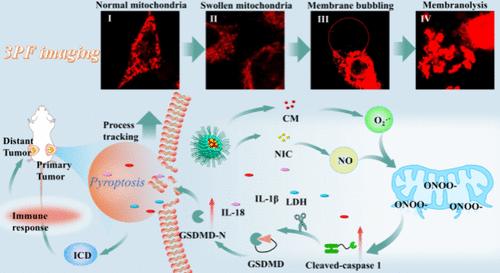A Highly Efficient Pyroptosis Activator for Three-Photon Fluorescence Imaging-Guided Phototherapy and Hypoxia Tumor Immunotherapy
IF 6.7
1区 化学
Q1 CHEMISTRY, ANALYTICAL
引用次数: 0
Abstract
Pyroptosis is a highly immunogenic form of programmed cell death capable of eliciting inflammation and enhancing antitumor immune responses. However, there remains a lack of effective visualization of pyroptosis processes and deep-penetrating organelle-targeted photosensitizers in cancer treatment strategies. Here, we develop two aggregation-induced emission (AIE) pyroptosis inducers (CM1-NIC@F127 and CM2-NIC@F127), which are found to proficiently generate reactive nitrogen species (RNS) under hypoxic tumor conditions. The visualization of cellular mitochondrial swelling and the formation of large vesicles throughout the pyroptosis process are achieved owing to their excellent three-photon fluorescence (3PF) properties. Mechanistically, the mitochondria experience dysfunction after phototherapy treatment because of their hypersensitivity to free radical active substances. Cleaved-caspase 1 activation is observed during pyroptosis, leading to the gasdermin D (GSDMD) cleavage fragment GSDMD-N and initiating an inflammatory response. CM1-NIC@F127 promotes dendritic cell (DC) maturation and cytotoxic T cell activation due to the enhanced immunogenic cell death (ICD) effect, leading to the inhibition of both primary and distant tumor growth. Thus, this study provides ideas and strategies for tumor immunotherapy mediated by RNS-induced pyroptosis that has a good therapeutic effect on tumors.

一种用于三光子荧光成像引导光疗和缺氧肿瘤免疫治疗的高效热凋亡激活剂
焦亡是一种高度免疫原性的程序性细胞死亡形式,能够引发炎症并增强抗肿瘤免疫反应。然而,在癌症治疗策略中,仍然缺乏有效的可视化焦亡过程和深穿透细胞器靶向光敏剂。在这里,我们开发了两种聚集诱导发射(AIE)焦亡诱导剂(CM1-NIC@F127和CM2-NIC@F127),发现它们在缺氧肿瘤条件下能熟练地产生活性氮(RNS)。由于其优异的三光子荧光(3PF)特性,在整个焦亡过程中实现了细胞线粒体肿胀和大囊泡形成的可视化。从机制上讲,由于线粒体对自由基活性物质的超敏反应,光疗后线粒体出现功能障碍。在焦亡过程中观察到裂解的caspase 1激活,导致气皮蛋白D (GSDMD)裂解片段GSDMD- n并启动炎症反应。CM1-NIC@F127通过增强免疫原性细胞死亡(ICD)效应促进树突状细胞(DC)成熟和细胞毒性T细胞活化,从而抑制原发和远处肿瘤的生长。因此,本研究为rns诱导的焦亡介导的肿瘤免疫治疗提供了思路和策略,对肿瘤具有良好的治疗效果。
本文章由计算机程序翻译,如有差异,请以英文原文为准。
求助全文
约1分钟内获得全文
求助全文
来源期刊

Analytical Chemistry
化学-分析化学
CiteScore
12.10
自引率
12.20%
发文量
1949
审稿时长
1.4 months
期刊介绍:
Analytical Chemistry, a peer-reviewed research journal, focuses on disseminating new and original knowledge across all branches of analytical chemistry. Fundamental articles may explore general principles of chemical measurement science and need not directly address existing or potential analytical methodology. They can be entirely theoretical or report experimental results. Contributions may cover various phases of analytical operations, including sampling, bioanalysis, electrochemistry, mass spectrometry, microscale and nanoscale systems, environmental analysis, separations, spectroscopy, chemical reactions and selectivity, instrumentation, imaging, surface analysis, and data processing. Papers discussing known analytical methods should present a significant, original application of the method, a notable improvement, or results on an important analyte.
 求助内容:
求助内容: 应助结果提醒方式:
应助结果提醒方式:


